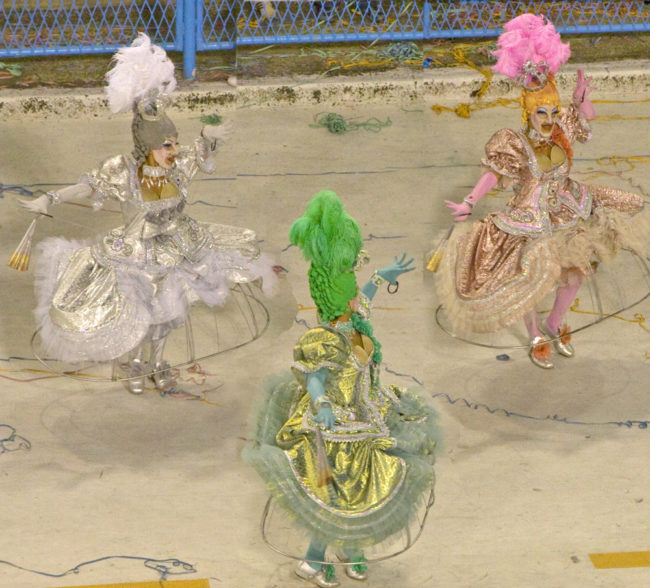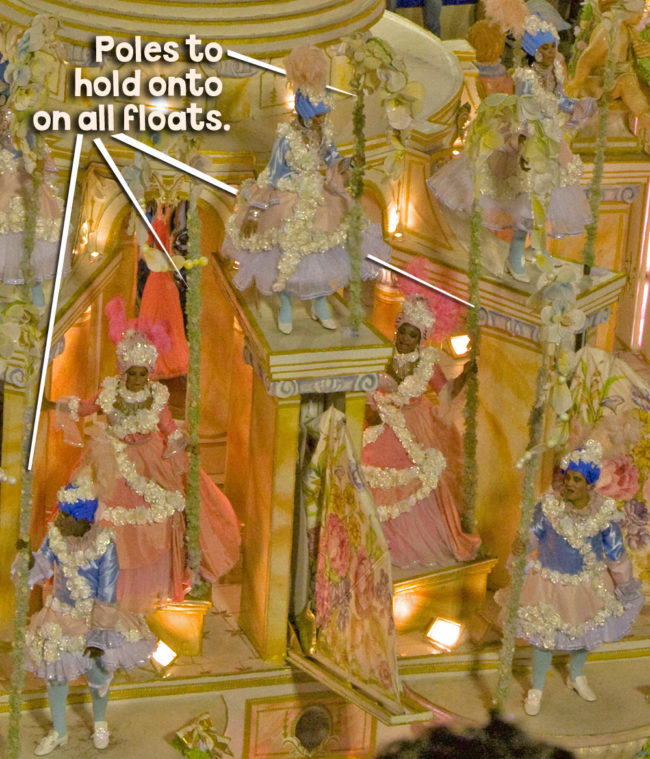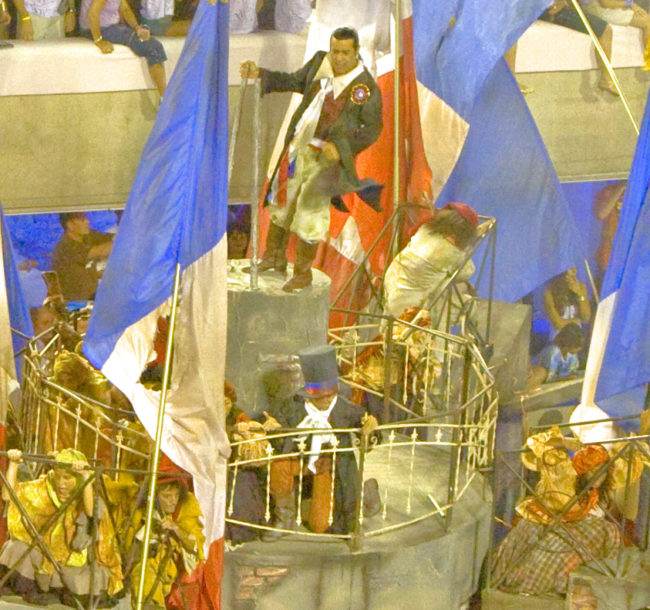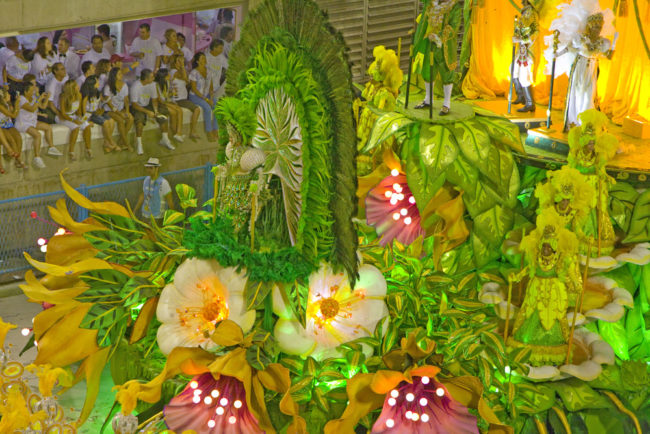Second day in Rio, part 6–Carnaval
Imperatriz salutes John and his Marys
During the intermission, we had a chance to begin real conversations with the new friends who surrounded us in the stands. To begin with, they were delightfully accommodating to us when we came barging down the wet aisle to find seats. Jean’s “obrigado” was the first thing that clued them in to our Americanness. Yeah, right. I’m sure Robo and Pettus’ blonde hair glinting in the lights of the Sambódrome didn’t tip our hand either. Unless they were mistaken as Argentinian. We’re also lucky that Robo’s delightful sarcasm at the end of Tijuca’s performance didn’t get us tarred and feathered. Though the feathers would have been beautiful.
It was a big guy about my age who had handed us the Tijuca flags. He was surrounded by friends, including his sister (I think she was). During Tijuca, we would nod excitedly to each other, me scattering belezas like fish food; Robo, Jean and Pettus beaming with international smiles. And don’t think we didn’t regale our new Brazilian pals with a heaping helping of “gah-lay”s, either, because our hyperpolic American slang blended in beautifully with the samba theme.
 The guy’s sister sitting next to me was Flávia Rios, a lawyer from Rio. She was ebullient, friendly, and made us all glad we had picked those seats. The friends she had with her were equally pleasant, but she was clearly the ringleader of fun. I tried all the Portuguese on her I had in my bag, and eventually began mixing it with Spanish, which she was more familiar with than English or my mishandling of her verbs and nouns. Around this time, one of the many vendors climbed the bleachers stepping through the crowd like he was dodging land mines. It was amazing. Their balance while holding giant coolers on their shoulders was uncanny. Then being able to park in front of their customers, cooler on a bended knee, while hardly causing a stir at all–it was more than I could take in. Flávia bought us a beer just as the massive explosion of fireworks to our east announced the arrival of Imperatriz.
The guy’s sister sitting next to me was Flávia Rios, a lawyer from Rio. She was ebullient, friendly, and made us all glad we had picked those seats. The friends she had with her were equally pleasant, but she was clearly the ringleader of fun. I tried all the Portuguese on her I had in my bag, and eventually began mixing it with Spanish, which she was more familiar with than English or my mishandling of her verbs and nouns. Around this time, one of the many vendors climbed the bleachers stepping through the crowd like he was dodging land mines. It was amazing. Their balance while holding giant coolers on their shoulders was uncanny. Then being able to park in front of their customers, cooler on a bended knee, while hardly causing a stir at all–it was more than I could take in. Flávia bought us a beer just as the massive explosion of fireworks to our east announced the arrival of Imperatriz.
These scary ladies, who all bore a striking resemblance to Wayland Flowers’ partner “Madam, began the parade: a salute to King John VI of Portugal, and the Marias in his orbit: his mother, Maria the Mad Queen of Portugal; Marie Antoinette; and Maria Leopoldína, his Austrian daughter-in-law. King John fled Napoleon’s nasty temper in 1808 for Portugal’s colony of Brazil and set up life and Portugal’s capital there. His influence on the culture and lives of Brazilians is celebrated heavily in Rio, and particularly this year as the bicentennial of the royal family’s arrival. Viva a Realeza! Long live royalty! (I think). Opulence and decadence were sure to follow, all to Imperatriz’ samba theme, a möbius strip of beats, extemporaneous exhortations, and the name “Maria” the only thing recognizable out of the thick mass.
 I began to notice more about the parades, like the existence of a gaggle of sideline coaches and conductors. This guy could just as well be working a soccer match, with that pose.
I began to notice more about the parades, like the existence of a gaggle of sideline coaches and conductors. This guy could just as well be working a soccer match, with that pose.
 I had a hard time figuring out who these next guys were supposed to be. Were they the King and Maria in bedclothes with the beds attached? Were those things mirrors? I had no idea. The picture looks like these folks are kind of panicking because they’re tangled up or something.
I had a hard time figuring out who these next guys were supposed to be. Were they the King and Maria in bedclothes with the beds attached? Were those things mirrors? I had no idea. The picture looks like these folks are kind of panicking because they’re tangled up or something.
 I wasn’t quite sure what the next two groups were. I think they were fancy men followed by fancy women. Don’t tell me those costumes aren’t hot as hell.
I wasn’t quite sure what the next two groups were. I think they were fancy men followed by fancy women. Don’t tell me those costumes aren’t hot as hell.
 Flávia told me that the flag couple were stars in Brazil, and that most of the solo hotties were, as well. That was the first I had heard of this phenomenon, but it made sense. It also would help in the competition to have a huge star in your show. There were many elements that made up the judges’ eventual score, and that was just one of them. I read that the performance of these flag-bearing couples can rack up 40 points. It didn’t say out of how many total, but it sounded important nevertheless.
Flávia told me that the flag couple were stars in Brazil, and that most of the solo hotties were, as well. That was the first I had heard of this phenomenon, but it made sense. It also would help in the competition to have a huge star in your show. There were many elements that made up the judges’ eventual score, and that was just one of them. I read that the performance of these flag-bearing couples can rack up 40 points. It didn’t say out of how many total, but it sounded important nevertheless.
 All of the floats had poles for the riders to hold onto. When everybody starts to samba together on one of those things, the sway is rhythmic and can be rather drastic. Without the poles, they’d be flinging people into the crowd from both sides. I think it would be kind of scary to ride on one, being such a vertiginous sort.
All of the floats had poles for the riders to hold onto. When everybody starts to samba together on one of those things, the sway is rhythmic and can be rather drastic. Without the poles, they’d be flinging people into the crowd from both sides. I think it would be kind of scary to ride on one, being such a vertiginous sort.
 The next float looks like a representation of the French Revolution. Uhh. Yeah. Marie Antoinette and all.
The next float looks like a representation of the French Revolution. Uhh. Yeah. Marie Antoinette and all.


 Next came the Brazilian hottie. She was an exotic bird on acid as she pranced her beautiful self around. The picture of the conductor and the single percussion guy looks like he’s telling him not to come yet–the star was still performing in that space. I don’t know, though, he could have been a star in his own right, and doing a little tambourine solo or something.
Next came the Brazilian hottie. She was an exotic bird on acid as she pranced her beautiful self around. The picture of the conductor and the single percussion guy looks like he’s telling him not to come yet–the star was still performing in that space. I don’t know, though, he could have been a star in his own right, and doing a little tambourine solo or something.

 The golden twirlers that followed were so very cool. You can’t tell anything from a still picture, but when all that gold starts rotating at the same time, changing directions like birds in flight, it is mind blowing. Plus, you couldn’t see their arms so well under those enormous costumes. Woo-WEE!
The golden twirlers that followed were so very cool. You can’t tell anything from a still picture, but when all that gold starts rotating at the same time, changing directions like birds in flight, it is mind blowing. Plus, you couldn’t see their arms so well under those enormous costumes. Woo-WEE!
 The gigantic horses that followed the golden girls were impressive, to say the least. Especially the way they trotted in time to the music. Part sympathetic vibrations, yes, but was somebody moving them? I don’t know if that was true in this case. This float was an eye-popper with two bigwigs on top. I would think the horses would have gotten tired from pulling not only the coach with all those people, but the house as well. The guy in the green jumpsuit looks half like a trainer and half like the guy who is in charge of scooping up giant Plaster of Paris horse patties.
The gigantic horses that followed the golden girls were impressive, to say the least. Especially the way they trotted in time to the music. Part sympathetic vibrations, yes, but was somebody moving them? I don’t know if that was true in this case. This float was an eye-popper with two bigwigs on top. I would think the horses would have gotten tired from pulling not only the coach with all those people, but the house as well. The guy in the green jumpsuit looks half like a trainer and half like the guy who is in charge of scooping up giant Plaster of Paris horse patties.
 Dolphins and parakeets followed the horses. I didn’t know what they represented, but now think they show the King’s passage to Brazil and his discovery of dolphins and parakeets.
Dolphins and parakeets followed the horses. I didn’t know what they represented, but now think they show the King’s passage to Brazil and his discovery of dolphins and parakeets.
 Following my theory, this next group are the new types of cooks he met in Brazil, and the new foods that he found here.
Following my theory, this next group are the new types of cooks he met in Brazil, and the new foods that he found here.


And do you have these flowers in Portugal, your majesty? Don’t forget the great fishing, King!


 The favorite thing found by the King when he came to Brazil was gold. It had already caused all kinds of trouble and resulted in meanness and body parts toted through the city. I wonder if the bankers were the ones who wanted to represent gold.
The favorite thing found by the King when he came to Brazil was gold. It had already caused all kinds of trouble and resulted in meanness and body parts toted through the city. I wonder if the bankers were the ones who wanted to represent gold.
 It’s fun trying to put my made up Brazilian history with what I think these floats are. Therefore, I will tell you that this next float represents the botanical gardens that were started by King John VI. And yes, after a quickie Google, I find that this was indeed the king that graced the city with one of the most stunning gardens in the world. But I should have known that already, because Marcelo told us all about it when we saw them in all their glory ourselves. Stupid! Stupid! Stupid!
It’s fun trying to put my made up Brazilian history with what I think these floats are. Therefore, I will tell you that this next float represents the botanical gardens that were started by King John VI. And yes, after a quickie Google, I find that this was indeed the king that graced the city with one of the most stunning gardens in the world. But I should have known that already, because Marcelo told us all about it when we saw them in all their glory ourselves. Stupid! Stupid! Stupid!


The batch of foliage that followed I was not sure of. Maybe Spanish Dagger women? Did they bring these over from Portugal to Brazil?
 The last float featured people in weird poodle puff outfits representing what I don’t know. It surely was also peopled with members of the old guard, who had been with Imperatriz for years, or were important to the school. They played big parts on many floats as well, and were sprinkled throughout the performance in key places.
The last float featured people in weird poodle puff outfits representing what I don’t know. It surely was also peopled with members of the old guard, who had been with Imperatriz for years, or were important to the school. They played big parts on many floats as well, and were sprinkled throughout the performance in key places.


